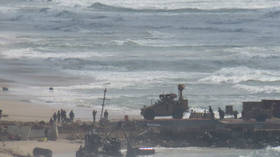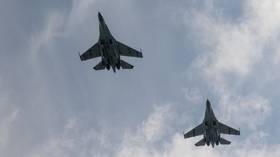US aid mission in Gaza more disastrous than acknowledged – investigation

The US military’s humanitarian pier mission in Gaza last year resulted in far more injuries, damage, and operational failure than previously publicly acknowledged, an investigation has found.
The mission, formally known as Operation Neptune Solace, was launched under the administration of former President Joe Biden in 2024 after the US failed to persuade Israel to expand overland access for humanitarian deliveries. The US military constructed a temporary offshore pier and floating causeway to transfer aid from ships to the Gaza shoreline without entering Israeli or Gazan ports.
The Pentagon had since acknowledged that the mission encountered certain challenges, such as rough weather conditions, which caused damage to the pier but did not disclose the full scope of the problems.
Did they not know the weather would be rough? My counterpart in Israel could have told them what to expect.
According to the Department of Defense Inspector General’s report, which was published last week, the mission caused 62 injuries among personnel, including the death of Army Sergeant Quandarius Stanley, who was critically injured aboard a Navy vessel in May 2024 and died five months later.
“The Army and Navy did not meet Service-level standards for equipment and unit readiness for their watercraft units,” the report stated, adding that neither service organized, trained, and equipped their forces to meet common joint standards. It also faulted the Transportation Command for shortcomings in logistics planning and exercises.
The report also concluded that the mission cost approximately $230 million and led to $31 million in repair costs after more than two dozen watercraft and equipment pieces were damaged. It further underlined the questionable value of the operation, given that it ran for a total of three months but was actually functional for only about 20 days.
During that time, the US military said it had delivered approximately 20 million pounds of food and supplies via the pier. However, aid groups had stated that Gaza required that amount on a daily basis to avert famine.
$261 million dollars, not counting the cost of the food or shipping, for one-day's worth of food supplies. Has anyone been court-marshalled? Is it time for a 'Black Hawk Down' type of movie?
The humanitarian situation in Gaza has deteriorated sharply as a result of Israel’s military response to the attack on its territory by Hamas militants in 2023. Israel has been accused of indiscriminate bombings, deliberate destruction of civilian infrastructure, and obstruction of humanitarian aid, which have reportedly led to the deaths of over 50,000 Palestinians. The imposed blockade has led to severe shortages of food, medical supplies, and other essential resources, according to international organizations.
The 'indiscriminate bombings' referred to here are a result of Hamas hiding themselves among civilians, in schools, hospitals, ambulances, etc., etc.
No mention here of the thousands of tons of food and medical aid that was stolen by Hamas and other criminal gangs to be used by Hamas or sold on the black market.
Humanitarian organizations have repeatedly criticized both the US and Israeli governments for failing to unblock overland aid deliveries to Gaza and dismissed Washington’s efforts to open alternative routes as politically motivated.
But they have not complained about Hamas stealing food and medication, or hiding among civilians and children, or not just laying down their weapons and leaving Gaza the way they came.
Over 500 Ukrainian drones shot down in one day – Russia

Russian anti-aircraft defenses have repelled a large-scale Ukrainian attack, downing two Western-supplied HIMARS rockets and over 500 drones, the Defense Ministry in Moscow said on Wednesday. Five long-range Neptune guided missiles and six JDAM precision-guided aerial bombs were also destroyed.
Aerial assaults have increased in the lead-up to a ceasefire declared by Russian President Vladimir Putin, which is scheduled to take effect from midnight on May 7–8 through midnight on May 10–11.
Intended as a humanitarian gesture to commemorate the 80th anniversary of the Soviet victory over Nazi Germany, the three-day pause also opens the door to potential “direct negotiations with Kiev without preconditions,” Moscow said.
Kremlin spokesperson Dmitry Peskov confirmed on Wednesday that Russia still plans to offer the 3-day ceasefire.
By ramping up drone strikes on Russia, “the Kiev regime continues to demonstrate its essence, its inclination to terrorist actions,” Peskov said.
Ukraine’s Vladimir Zelensky has declined to support the proposed ceasefire, calling it a Russian “attempt at manipulation.” According to the Russian Foreign Ministry’s war crimes investigator Rodion Miroshnik, the past week saw a record number of civilian casualties from drone attacks, with 15 people killed and 142 others injured.
500+ drones and missiles killed 15 civilians, and at what cost? The 13 missiles mentioned would have cost tens of thousands of dollars each, while the drones might be available for as little as $500. That's a quarter of a billion dollars just for the drones, and probably a similar sum for the missiles. Are 15 civilians worth half a billion dollars? Isn't there something useful that money could have been used for?
EU nation backtracks on Ukraine F-16s promise

Belgium will only be able to deliver F-16s to Ukraine “in the years to come,” Defense Minister Theo Francken has said, after his country initially promised to provide Kiev with jets last year. Brussels must first receive its own delivery of F-35s from the US, Francken stated.
Belgium – along with fellow NATO members Denmark, the Netherlands, and Norway – pledged in 2023 to arm Kiev with up to 80 F-16s after receiving permission to do so from the administration of then-US President Joe Biden. Last year, Ukraine received about 20 of the aircraft from Denmark and the Netherlands.
Speaking at an event organized by the Atlantic Council think tank in Washington on Tuesday, Francken claimed Belgium was Kiev’s “biggest supporter on the air domain,” despite his country not yet providing Ukraine with any planes.
Brussels is “delivering 30 working F-16s [to Ukraine] in the years to come, as soon as possible,” he added.
Francken explained the delay by saying that “when we have our F-35s [from the US], we will give the F-16s because we have DCA (Dollar Cost Averaging) capacity in Belgium.”
He insisted that Belgium is “very forward leaning” towards Kiev and “will support [Vladimir] Zelensky and every Ukrainian because it is very important.”
Last month, Belgian Prime Minister Bart De Wever said the country will send two non-operational F-16s to Ukraine to be used for spare parts by the end of 2025.
De Wever also announced that Brussels will provide €1 billion ($1.1 billion) in military support to Kiev annually. According to Francken, the package “will pass the government within a few weeks.”
Last week, the US approved a $310.5 million deal to sustain Ukrainian-operated F-16s, which includes training, spare parts, aircraft modifications, logistics assistance, and software support for the fourth-generation aircraft.
The Defense Ministry in Moscow reported in April that Russian air defenses had shot down an F-16, making it the second confirmed loss of a US-designed jet operated by Ukraine.
The Ukrainian authorities initially claimed that F-16s would be a game-changer in the conflict with Russia. However, their use in combat has been limited, with the aircraft mainly being deployed away from the contact line for air defense purposes.
Inexperienced F-16 pilots are probably more dangerous to themselves than they are to their enemies. This is just another way to kill Ukrainians while selling kazillions of dollars worth of F-35s to Belgium.
Are Europeans really so stupid that they can't see what is going on here?





No comments:
Post a Comment